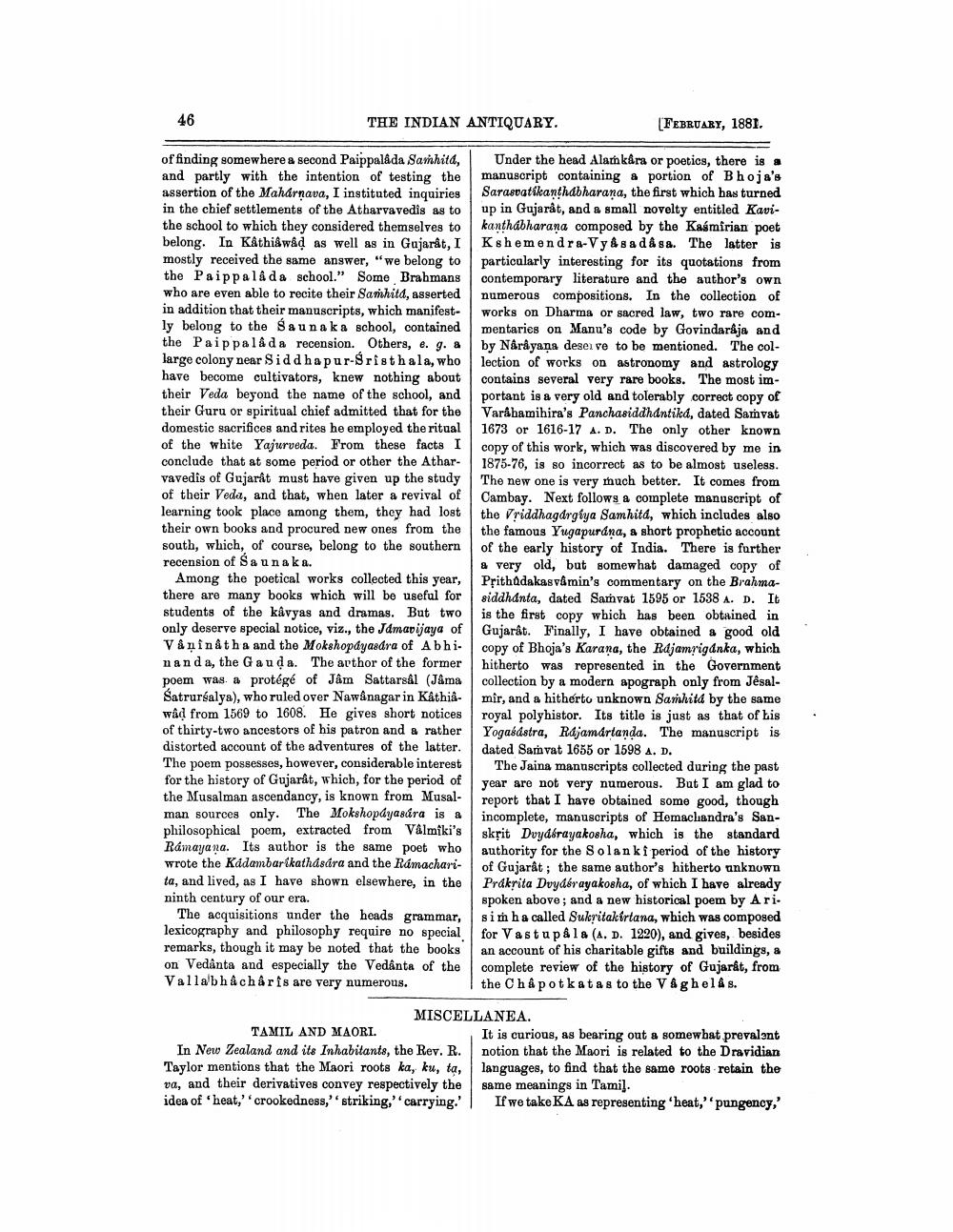________________
46
THE INDIAN ANTIQUARY.
(FEBRUARY, 1881.
of finding somewhere a second Paippalada Samhita, Under the head Alatkâra or poetics, there is a and partly with the intention of testing the manuscript containing a portion of Bhoja's assertion of the Maharnava, I instituted inquiries Sarasvatikanthabharana, the first which has turned in the chief settlements of the Atharvavedis as to up in Gujaråt, and a small novelty entitled Kavithe school to which they considered themselves to kanthábharana composed by the Kasmirian poet belong. In Kathiawad as well as in Gujarat, I Kshemendra-V y Asad&sa. The latter is mostly received the same answer, "we belong to particularly interesting for its quotations from the Paippala da school." Some Brahmans contemporary literature and the author's own who are even able to recite their Sanhitd, asserted numerous compositions. In the collection of in addition that their manuscripts, which manifest- works on Dharma or sacred law, two rare comly belong to the saunaka school, contained mentaries on Manu's code by Govindaraja and the Paippalada recension. Others, e. g. & by Narayana deserve to be mentioned. The collarge colony near Siddhapur-Sristhala, who lection of works on astronomy and astrology have become cultivators, knew nothing about contains several very rare books. The most imtheir Veda beyond the name of the school, and portant is a very old and tolerably correct copy of their Guru or spiritual chief admitted that for the Varábamihira's Panchasiddhantikd, dated Samvat domestic sacrifices and rites he employed the ritual 1673 or 1616-17 A. D. The only other known of the white Yajurveda. From these facts I copy of this work, which was discovered by me in conclude that at some period or other the Athar- 1875-76, is so incorrect as to be almost useless. vavedis of Gujarat must have given up the study The new one is very much better. It comes from of their Veda, and that, when later a revival of Cambay. Next follows a complete manuscript of learning took place among them, they had lost the Vriddhagdrgiya Samhitd, which includes also their own books and procured new ones from the the famous Yugapurána, a short prophetic account south, which, of course, belong to the southern of the early history of India. There is further recension of Saunaka.
& very old, but somewhat damaged copy of Among the poetical works collected this year, Prithadakasvamin's commentary on the Brahmathere are many books which will be useful for siddhanta, dated Samvat 1595 or 1538 A. D. It students of the kavyas and dramas. But two is the first copy which has been obtained in only deserve special notice, viz., the Jdmavijaya of Gujarat. Finally, I have obtained a good old V&ņinatha and the Mokshopdyasdra of Abhi. copy of Bhoja's Karana, the Rajamriganka, which nanda, the Gauda. The author of the former hitherto was represented in the Government poem was a protégé of Jâm Sattarsal (J&ma collection by a modern apograph only from JêsalSatrursalya), who ruled over Nawanagarin Kathiả. mir, and a hitherto unknown Sanhitd by the same wâd from 1569 to 1608. He gives short notices royal polyhistor. Its title is just as that of his of thirty-two ancestors of his patron and a rather Yogasastra, Rajamarlanda. The manuscript is distorted account of the adventures of the latter.
dated Samvat 1655 or 1598 A. D. The poem possesses, however, considerable interest The Jaina manuscripts collected during the past for the history of Gujarat, which, for the period of
year are not very numerous. But I am glad to the Musalman ascendancy, is known from Musal- report that I have obtained some good, though man sources only. The Mokshopdyasára is a
incomplete, manuscripts of Hemachandra's Sanphilosophical poem, extracted from Vålmski's skřit Duydérayakosha, which is the standard Ramayana. Its author is the same poet who authority for the Solanki period of the history wrote the Kddambarikathasdra and the Ramachari- of Gujarat; the same author's hitherto unknown ta, and lived, as I have shown elsewhere, in the Prakrita Dvydérayakosha, of which I have already ninth century of our era.
spoken above; and a new historical poem by Ari. The acquisitions under the heads grammar, simha called Sukritakértana, which was composed lexicography and philosophy require no special for Vastupala (A.D. 1220), and gives, besides remarks, though it may be noted that the books an account of his charitable gifts and buildings, a on Vedanta and especially the Vedanta of the complete review of the history of Gujarât, from Vallabh & charis are very numerous. | the Châ potkat as to the Vaghel s.
MISCELLANEA. TAMIL AND MAORI.
It is curious, as bearing out a somewhat prevalent In New Zealand and its Inhabitants, the Rev. R. notion that the Maori is related to the Dravidian Taylor mentions that the Maori roots ka, ku, ta, languages, to find that the same roots retain the va, and their derivatives convey respectively the same meanings in Tamil. idea of heat,' crookedness,' striking,' carrying. If we take KA as representing 'heat," pungency,'




